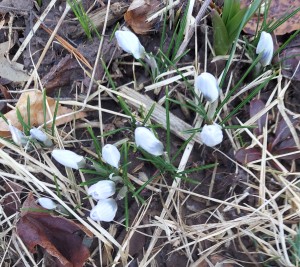 Seeing the first small snow crocuses each year is akin to discovering that someone scattered jewels over your garden at night. My first tiny, goblet-shaped flowers usually peek out from under the privet hedge on the north side of the house. Later, a few appear in the front strip, generally alongside the somewhat showier snowdrops. Snow crocuses are among the “little bulbs” that fabled American garden writer Elizabeth Lawrence celebrated in her wonderful 1957 book of the same name.
Seeing the first small snow crocuses each year is akin to discovering that someone scattered jewels over your garden at night. My first tiny, goblet-shaped flowers usually peek out from under the privet hedge on the north side of the house. Later, a few appear in the front strip, generally alongside the somewhat showier snowdrops. Snow crocuses are among the “little bulbs” that fabled American garden writer Elizabeth Lawrence celebrated in her wonderful 1957 book of the same name.
Snow crocus or Crocus chrysanthus, are early bloomers and about half the size of their later blooming, Dutch crocus relatives. They are amazingly powerful little plants, pushing up through the frozen earth, shrugging off snowstorms, and bursting into bloom the minute the first thin rays of late winter sunshine strike them.
Though they have delighted people all over the world for years, snow crocuses originated in areas that are now part of Greece, Bulgaria and Turkey, eventually emigrating to the more northerly parts of Europe, and, in due course, to North America. “Krokos” was the term ancient Greeks used for the related saffron crocus, now known as Crocus sativus. “Chrysanthus” means “flowers of gold”, which is apt, since some varieties, like ‘Goldilocks’ and ‘Zwanenberg Bronze’ feature golden petals. Planted en masse, the yellow or golden varieties look like pools or even rivers of sunshine.
But gold is not the only color that may tint the petals of snow crocus. One of my favorites, ‘Snow Bunting’, was also Elizabeth Lawrence’s top choice. It is creamy white with golden orange stigmas that light up the centers of the flowers when they are fully open. The fragrance has been described as “musky, but I do not find it objectionable. ‘Cream Beauty’, with just a touch more yellow than ‘Snow Bunting’, is lovely alongside or mixed in with ‘Blue Pearl’, beautifully adorned in shades of pale blue that are slightly darker on the outside of the petals than inside the flower.
Snow crocus petals may also offer combinations of two or more colors. ‘Prins Claus’, bred in the Netherlands, features white petals, marked on the outside with deep purple. You have to get close to the flower to notice, but the prince also has a spicy-sweet fragrance that mixes nicely with the honey scents of the snowdrops and the earthy smell of the mud in late winter and early spring. ‘Blue Marlin’ has nothing to do with the fish of the same name, but boasts petals that mix lighter and darker purple. ‘Gypsy Girl’ is like a tiny tiger, its golden yellow petals marked on the outside with brown stripes.
One of the best things about snow crocus is that you can buy a great number of them for very little money. Installed in the fall, in clumps of three, five or nine, they will bloom early the following spring, or even in late winter depending on where you live. The petals open fully to receive the warm sunshine, but close up in rain or darkness. Older, better established clumps tend to bloom just a bit earlier than more recently established ones, giving you a slightly longer season of bloom. Over time the clumps will also expand, making snow crocus a good long term garden investment.
Like many good things—chocolate cake, unlined skin, perfect weather—snow crocuses are ephemeral. They bloom, produce grasslike leaves, and fade before summer sets in. Take pictures of the garden locations that are home to established clumps, so you won’t dig them up when fall planting time arrives.
And, speaking of digging…Many gardeners have trouble with rodents digging up and/or eating bulbs. There are many ways to combat them, including planting bulbs in cages made of chicken wire or hardware cloth. Directions for making these cages are easily accessible on the internet. You can also spray new bulbs with animal repellent before planting, and cover planted areas with mint leaves, lavender trimmings, onion grass, or other organic materials that smell foul to rodents.
Like other spring-blooming bulbs, snow crocuses like free draining soil and sunshine. They shine in garden beds and can be naturalized in lawns. Fortunately, even those planted under deciduous trees do well because they put on their show long before the trees even begin to think about leafing out. You can also plant the bulbs in containers, but since they are ephemeral, you may want to use lightweight pots that you can pop into larger, more decorative containers while the crocuses are blooming. Once the show is over, pop them out again and replace with summer annuals.
In late spring and early summer bulb vendors start marketing offerings for fall planting. Make a note to buy lots of crocus chrysanthus. Your life will be better and your late winter seasonal affective disorder will lift more quickly next spring.
For a good selection try Brent and Becky’s Bulbs, 7900 Daffodil Lane, Gloucester, VA 23061; (877) 661-2852; www.brentandbeckysbulbs.com. Print catalog available.
